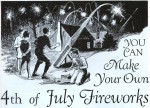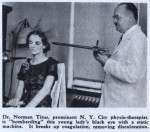-

YOU CAN Make Your Own 4th of July Fireworks (Jul. 1930 issue of Modern Mechanics)
THIS month’s chemical section is dedicated to that noble and glorious purpose of celebrating the Fourth of July in noisy fashion—and with cannon crackers and colored fire that can safely be made in your own lab. However, before plunging into a pile of recipes and formulas it is necessary to warn you fellows to be extremely careful in preparing these mixtures. In themselves they will not blow up until brought into actual contact with fire or through extreme friction, but remember always that you are working with explosives—regardless of how mild they may be away from fire.
To overcome the dangers of friction it is well to mix your powders in small doses. A simple way is to put them on a sheet of fairly substantial paper and, by picking up two ends, rolling the powder back and forth as you raise and lower your hands alternately. But where you must use your pestle and mortar—watch out for friction!
…
And now, here are the formulas. But remember, all the ingredients must be dry and powdered separately and then mixed on a sheet of paper, without friction. Always bear in mind that sulphur and chlorate of potassium will “go boom” when rubbed together. Keep the ingredients away from open flames.
A nice bright red fire can be made by using 20 parts of strontium nitrate finely powdered, six parts of sulphur, 5 parts of saltpetre and one part of lampblack. Your druggist can supply them all in powdered form. They may cost a few cents more that way, but it is safer than trying to powder them yourself.
And so on.
The 1930s were a dangerous time.
(Via Modern Mechanix)


